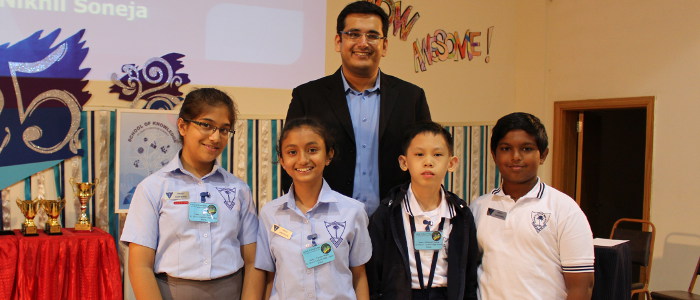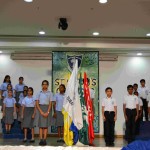Anyone who has been in the UAE for some time will know of someone who has been educated at St. Mary’s. Practically an institution, St Mary’s, based in Oud Metha in Dubai, is home to almost 1929 students, girls and boys, aged from 5 to 19. The school is one of the oldest educational institutions in the Emirates. It was founded in 1968, and is said to be something of an anomaly in following a broadly Catholic curriculum for Religious Studies (a choice of study is allowed).
The largest group of students at the school come from India, followed by those from the Philippines, other Asian countries and Pakistan. A very few Western expatriate students can be found at the school, but clearly are very much in a minority and very exotic to the general population. Parents of the latter group view the school as something of a hidden gem – good results, very low cost (for a UK curriculum based school) albeit one where facilities cannot be compared to mid-to premium priced schools and where choices of study are considerably more limited.. The exact number of GCSEs and A Levels will vary year on year.
The schools employs 136 teachers, predominantly from India, and perhaps because of the nature of the school teacher turnover is low by Dubai standards – currently at 12%. The school has a fairly healthy teacher:student ratio of 1:14.
The school is rated highly by past and present students. It is run pretty much like most Catholic schools around the world – strict, ‘known’ to produce good results. The latter is largely anecdotal – the school’s web site has been improved in terms of design, but information is still missing. Extracting actual results is not possible. The school’s KHDA report in 2012/13 did however note “outstanding attainment in external examinations in English, mathematics and science”. The school does not detail the results on its web site – its achievements page is empty.
Key strengths of the school include students’ personal responsibility (outstanding in the secondary phase); Students’ understanding of Islamic values and Emirati culture (outstanding); students’ understanding of their community and their environmental responsibilities (outstanding in the secondary and post-16 phases). Students’ attainment and progress is Good in Maths, English and Science across all phases.
Despite these strengths, the school’s KHDA reports represent something of a yo-yo alternating between Good and Acceptable. This year is Good, 2014/15), and to be fair it is now the third year in a row of a Good rating. The school was last ranked Acceptable in 2011/12 when it was penalized for its Arabic language provision, at the time said to be “non-compliant”.
In 2013/14 the school has improved the attainment of secondary students in Arabic as an additional language, the attainment of primary students in English and mathematics, and the progress of primary students in science; It has raised the quality of students’ learning skills in primary and in post-16 students, their understanding of Islamic values and their local culture and global awareness; and the quality and use of assessment has improved, particularly in primary. Despite these improvements, Arabic and Islamic Studies remain areas highlighted as areas the school needs to improve in its most recent 2015 report.
The school follows the English National Curriculum and prepares students for I/GCSEs and A’ Levels. It has departments for English Language and Literature, Mathematics, Physics, Chemistry, Biology, Commerce, Arabic, Religious Studies, French, History, Art, ICT, Geography, Science, Social Studies and Citizenship. That gives it a fairly broad range of possible studies, but not as broad as you would find in (more expensive) schools elsewhere in Dubai. The range of possible subjects is not however a complaint raised by many students.
Students sit external GCSE examinations at the end of Year 11. At the end of Year 12, students complete a one year Advanced Level course and sit the examination. Some returned for Year 13 to take further Advanced level qualifications.
A greater number of complaints can be found regarding extra-curricular activities, which are limited. The school’s web site lists just four: Science Club, Environment Club, Web site journalism, and Sports. For sports, three main sports are followed: Basketball, Football and Volleyball.
Facilities at the school are sufficient, but not on a par with Dubai’s newest and shiniest institutions. Each of the rooms in the school has interactive white boards and projectors, the school has large fields and playing grounds; there’s a well spaced library equipped with a range of references and resources for research and studies and a multipurpose hall as a venue for different school events. The school’s cafeteria offers “healthy and hot foods” for staff and students.
Fees for the school are relatively highly affordable,but can rise up to over 17,000 AED for Year 12 for those students doing A’Levels with two labs based subjects (there is an extra fee above the tuition fee for use of the labs). (A student following humanities based A’Levels where there is no labs based work would pay less. The exact fee structure is a little complicated, but may be found here – you will see it is more expensive than the fees quoted below which are for tuition only.
Note 1: St. Mary’s has been oversubscribed for a number of years, especially in lower grades, and it is therefore a challenge to get into. Information of admissions may be found here. The school is becoming even more difficult to get into as it is currently reducing student numbers to be KHDA compliant.
Note 2: One thing we would like to give a thumbs up to is St Mary’s new web site. Given the fantastic history of the school, and the many good things it has to promote about the school online, it is great to finally see. The sections on results, and achievements is still empty however!

























